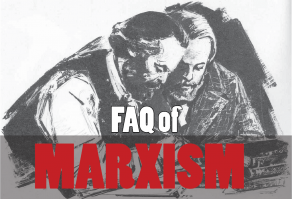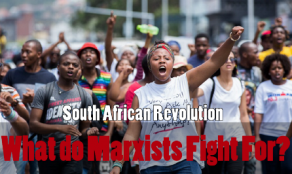In the final part of George Collins' history of the rise of Stalinism, he explains the bureaucracy's final victory over Trotsky's Left Opposition; their shameful co-operation with fascism and imperialism; and the brutal, counter-revolutionary role they played in suppressing the working class in Russia and internationally. He concludes with an optimistic assessment of the political situation in Russia in the late-80s, and while we know the tragic reality of what happened after the Soviet Union collapsed, a new revolutionary current has now gripped the minds of workers and youth worldwide.
Zinoviev and Kamenev, with their supporters, joined forces with Trotsky and the Opposition in 1926 in a struggle to pull the party back from Stalin's increasingly anti-Marxist course. Stalin, for his part, joined forces with the extreme right, pro-kulak wing of the party, headed by Bukharin, for the purpose of defeating the United Left Opposition.
This struggle was cut across by new upheavals internationally.
In Britain, the general strike of May 1926 provoked a profound crisis. The small Communist Party was presented with the opportunity of leading hundreds of thousands of workers in opposition to the reformist TUC leadership, and prepare the transfer of power to the working class.
But the Stalinist leadership in Russia was tied in an opportunistic alliance with the 'lefts' on the TUC General Council, and permitted no struggle against them. The TUC right wing betrayed the strike at the first opportunity. Stalin's 'left' allies offered no resistance.
After 10 days, with the strike still spreading, the General Council unanimously called it off and surrendered to the bosses. This condemned the British working class to a historic defeat.
"The cause of the proletarian revolution in the West", wrote Serge, "seemed lost for many years to come. And now an immense light was rising in the East; the Chinese masses...were advancing from victory to victory." (From Lenin to Stalin, page 44)
The Chinese working class was moving independently of the nationalist movement, the Kuomintang, led by the reactionary Chiang Kai-shek. The Chinese Communist Party was becoming a mass force. Shanghai and Hankow were in the hands of the workers. A struggle for power was inevitable.
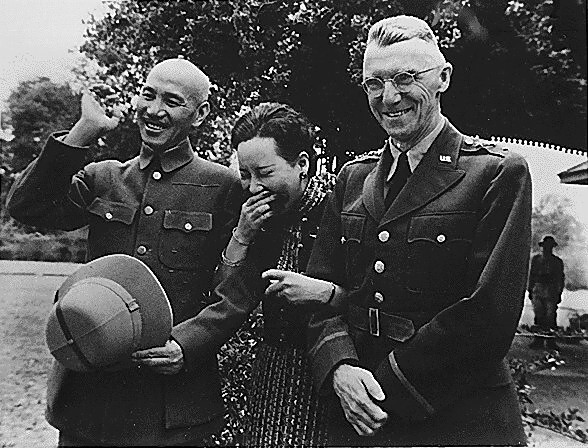 Chiang Kai Shek and wife with Lieutenant General Stilwell / Image: public domain
Chiang Kai Shek and wife with Lieutenant General Stilwell / Image: public domain
Again, Stalinist opportunism stood in the way of victory. Stalin and the Comintern leadership had dangerous illusions in Chiang Kai-shek, and declared the Kuomintang to be "a revolutionary bloc of the workers, peasants, intellectuals, and urban democracy [i.e. the capitalist class] on the basis of a community of class interests...in the struggle against the imperialists and the whole militarist-feudal order". (Resolution of ECCI, March 1926)
In practice this meant that the Communist Party had to submit to Chiang's authority. What was this except the old Menshevik idea of common struggle by the working class and the 'democratic capitalists' for democracy on a capitalist basis?
The Left Opposition fought this policy every inch of the way. They explained that Chiang was defending the capitalists and landlords; that a soviet (workers') government was needed to give land to the peasantry and establish democracy.
"We know that Chiang Kai-shek is preparing the open betrayal of the unions and his communist allies", wrote Serge, "We are not permitted to speak. And Stalin takes the floor in Moscow before thousands of workers and solemnly assures them that we have nothing to fear from Chiang Kai-shek." (From Lenin to Stalin, page 45)
Chiang used the opportunity that Stalin gave him to prepare a savage massacre of Communists and workers in April 1927. The Comintern (after flirting with a 'left' rival of Chiang, and suffering further defeats) swung over to an opposite, ultra-left course, and tried to engineer an insurrection in Canton. It was drowned in blood.
These events spelled the end of the Chinese Communist Party as a revolutionary workers' organization.
The Chinese Revolution set enormous shock waves in motion internationally.
"A wave of excitement swept over the [Soviet] party", Trotsky wrote. "The opposition raised its head...Many younger comrades thought the patent bankruptcy of Stalin's policy was bound to bring the triumph of the opposition nearer...
I was obliged to pour many a bucket of cold water over the hot heads of my young friends...The fact that our forecast had proved correct might attract one thousand, five thousand or even ten thousand new supporters to us.
But for the millions the significant thing was not our forecast, but the fact of the crushing of the Chinese proletariat. After the defeat of the German Revolution in 1923, after the break-down of the English general strike in 1926, the new disaster in China would only intensify the disappointment of the masses in the international revolution.
And it was this same disappointment that served as the chief psychological source for Stalin's policy of national-reformism [i.e. "socialism in one country"]." (My Life, pages 552-553)
Thus the international defeats, caused by the bureaucracy's shortsighted opportunism, at the same time strengthened the bureaucracy, and created conditions for the isolation and defeat of the Marxist opposition. Trotsky explains:
"The advanced workers were indubitably sympathetic to the Opposition, but that sympathy remained passive. The masses lacked faith that the situation could be seriously changed by a new struggle. Meantime the bureaucracy asserted: 'For the sake of an international revolution, the Opposition proposes to drag us into a revolutionary war. Enough of shake-ups! We have earned the right to rest. We will build the socialist society at home. Rely upon us, your leaders!' This gospel of repose...indubitably found an echo among the weary workers, and still more the peasant masses." (The Revolution Betrayed, page 92)
16. The defeat of the joint Left Opposition
In a major document entitled The Platform of the Joint Opposition (1927), Trotsky drew a balance sheet of ten years of Communist government, and reasserted the policies of Marxism in contrast to the blind opportunism of the bureaucracy.
The Platform called for the revival of the soviets, the restoration of workers' democracy, and a bold program of industrialization. Under pressure of the Opposition, the bureaucracy had put forward proposals for a limited five-year plan. But it was based on the kulaks' interests, and neglected the need for industrial development. The Platform explained the alternative:
"We must carry out in deeds a redistribution of the tax-burden among the classes - loading more heavily the kulak and Nepman, relieving the workers and the poor...
"we must steer a firm course towards industrialization, electrification and rationalization, based upon increasing the technical power of the economy and improving the material conditions of the masses." (pages 45-46)
The Opposition criticized Stalin's disastrous foreign policy of seeking "instant" support from left-reformist and nationalist leaders, rather than building the Comintern as a mass revolutionary force. The danger of imperialist attack, it explained, could only be defeated through an all-out struggle to mobilize the support of the mass of the working class internationally.
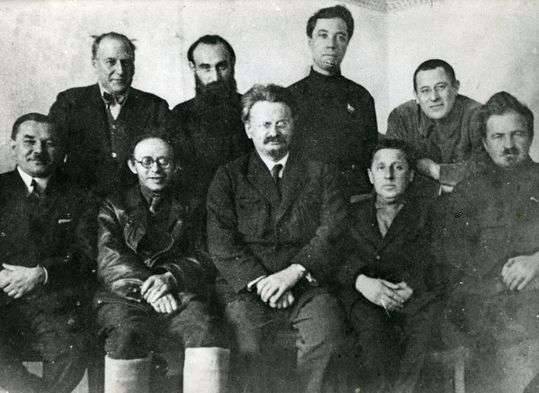 Trotsky and the Left Opposition in 1927 / Image: public domain
Trotsky and the Left Opposition in 1927 / Image: public domain
The bureaucrats had no answer to these ideas. Their "reply" was to unleash a campaign of vicious intimidation against the Opposition.
On the central committee, now packed with Stalin's hand-picked yes-men, Trotsky, Zinoviev and others were sworn at and howled down when they tried to speak. It was no better in the rest of the party. Victor Serge describes the scene in meeting after meeting:
"I had occasion to speak, or rather to try to speak, before gatherings shaken with a sort of frenzy. We were given the floor for five minutes after three-hour harangues. And against each of us they unleashed five, six, sometimes ten 'activists' eager to procure the favour of the secretaries. The crowd looked on passively, with a certain anxiety; they were often on our side, but they were afraid." (From Lenin to Stalin, page 49)
On the tenth anniversary of the October Revolution, in the face of this merciless witch-hunt, the Opposition heroically took their slogans to mass demonstrations in Moscow and Leningrad: "Let us turn our fire to the right - against the kulak, the nepman and the bureaucrat"; "Let us carry our Lenin's Will"; "Against opportunism, against a split, and for the unity of Lenin's party"!
The bureaucracy reacted with panic-stricken fury. They had seen, at a demonstration in Leningrad the previous month, how thousands of workers had flocked to listen to Trotsky and Zinoviev when, by mistake, the police had escorted them to a platform. Now the Opposition demonstrations were violently broken up. A shot was fired at Trotsky's car.
At the fifteenth congress, in December 1927, not one Oppositionist was permitted to attend as a delegate. 940 leading supporters of Trotsky were expelled. Yet the Opposition continued to fight for its ideas. The London Times, under the headline "Trotsky versus Stalin", reported:
"The views of the Opposition, in spite of all prohibitions and the efforts of the Ogpu [secret police] ... continue to be widely propagated by means of illegal pamphlets, which, according to Pravda, are each being printed in editions of tens of thousands..." (December 2, 1927)
Marxist opposition to the rule of the bureaucracy was from this point driven underground.
Zinoviev's and Kamenev's courage deserted them and, together with 2,500 supporters, they surrendered to Stalin. More expulsion of Trotskyists followed. Trotsky himself was expelled, exiled to Siberia [ed: it was actually Alma Ata], and then - because he remained a focal point for the Opposition - deported from the Soviet Union early in 1929.
In spite of these terrible blows, Trotsky and thousands of his supporters remained committed to the ideas of Bolshevism and the program of the October Revolution. In their propaganda they identified themselves as the Bolshevik-Leninists, to distinguish themselves from the upstart bureaucrats who had installed themselves at the head of the Communist movement.
From exile, Trotsky continued his theoretical work - his exposure of opportunism, pretences and treachery of the Stalinist bureaucracy, and his clarification of the Marxist alternative under rapidly changing conditions - that had formed perhaps his greatest contribution to Marxism. These ideas would serve as the guideline for a new revolutionary generation.
17. Proletarian bonapartism
From the late 1920s onwards the policies of the Soviet bureaucracy went through a series of bewildering zigzags, creating enormous confusion in the labor movement internationally.
The regime's supporters applauded each contradictory new turn as a 'correc' and 'necessary' measure to defend "socialism" in the USSR. Some opponents, despairing at the hideous travesty of 'Leninism' presented by the regime, claimed that the gains of the revolution had been destroyed, and that Russia could no longer be regarded as a workers' state in any sense.
Trotsky, grappling with these questions in the early 1930s, concluded that the Soviet workers' state had, in reality, degenerated into a regime of a new kind:
"As the bureaucracy becomes more independent, as more and more power is concentrated into the hands of a single person, the more does bureaucratic centrism turn into Bonapartism [named after the French military dictator, Napoleon Bonaparte]". (Writings 1934-35, page 180)
Bonapartism, Trotsky explained,
"was and remains the government of the bourgeoisie during periods of crisis... Bonapartism always implies political veering between classes; but under Bonapartism in all its historical transmigrations there is preserved one and the same social base: bourgeois [capitalist] property...
"It is absolutely correct that the self-rule of the Soviet bureaucracy was built upon the soil of veering between the class forces both internal and international. Insofar as the bureaucratic veering has been crowned by the... regime of Stalin, it is possible to speak of Soviet Bonapartism." (The Class Nature of the Soviet State, in Writings1933-34, pages 107-108)
The 'proletarian' character of this bonapartist regime arises from the fact that it is based not on 'bourgeois property', but on the state-owned and planned economy created by the October Revolution, reflecting the historical interest of the working class.
The regime's history from the 1920s onwards has been a graphic illustration of 'veering between class forces both internal and international'.
By 1927, precisely as the Opposition had warned, the kulaks were holding a gun to the head of the regime. To force prices up they withheld their grain from the marked, and hoarded gold and arms in preparation for a showdown.
The cities were threatened with hunger. The threat of capitalist restoration suddenly became real.
The bureaucracy reacted in panic, attempting to stamp out the danger by administrative decree and, where that failed, by force. They imposed compulsory requisitions of grain. The kulaks resisted; the bureaucracy responded with an all-out attack.
The Left Opposition had long explained the need for collectivization of the land, but stressed that this should be voluntary so as to keep the support of the peasants and minimize disruption. Stalin's declaration of war of the peasantry had nothing in common with Marxism; it was a blind reflex action, with disastrous results.
As late as 1929 Stalin maintained that "individual farming could continue to play a predominant role in supplying the country with food..." (Quoted by I. Deutscher, Stalin, page 320) Now, abruptly, the peasants' land was collectivized by decree. By 1930, 55 percent of peasant land had been turned into state farms, and 88 percent by 1934.
Rural Russia was convulsed by civil war. Famine broke out as the peasants slaughtered their animals sooner than give them to the regime. An estimated ten million people perished as a direct consequence of these bureaucratic excesses. Whole peasant communities and even whole national groups were murdered or deported. In the cities, bread rationing returned.
These events shattered NEP, ended Stalin's alliance with Bukharin and the party right wing, and formed the real basis for his plunge into violent ultra-leftism between 1927 and 1934.
Industrialization had long been argued for by the Opposition, and scornfully rejected under pressure from the right. Now Stalin could see no alternative to industrialization – as a panic measure, under ruthless compulsion from above. In 1928, prompted by the Opposition, the bureaucracy had half-heartedly adopted a five-year plan of economic development. Now, abruptly, the order went out to complete the plan in four years!
Vast projects were launched – dams, power stations, steel plants, mines – which transformed the Soviet Union within the space of a decade. While the capitalist world was plunged into the Depression of the 1930s, Soviet industrial production leaped ahead by 250 percent. Amazingly, backward Russia by 1935 produced more tractors than any other country in the world.
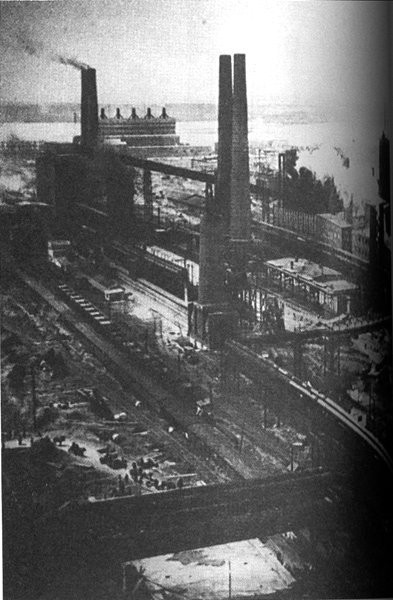 Industrial production advanced in Russia but at terrible cost / Image: public domain
Industrial production advanced in Russia but at terrible cost / Image: public domain
Under capitalism, such concerted development would have been impossible. Russia, under capitalism, would have continued to languish in hopeless poverty like most of the third world to this day.
"Socialism", said Trotsky, "has demonstrated its right to victory, not on the pages of Das Kapital... but in the language of steel, cement and electricity." (The Revolution Betrayed, page 8)
The Soviet Union's progress in the 1930s impressed working people the world over. But, under bureaucratic rule, it took place at a terrible cost.
Orders, often wildly unrealistic, were issued from bureaucrats' offices. Failure to execute them was treated as sabotage. Forced labour was used on a vast scale. Up to 15 million Soviet citizens – peasants who opposed collectivization and, later, opponents of every description – were herded into slave labour camps. Countless numbers perished.
The working class swelled from 11 million in 1928 to 23 million in 1932. Passes, called 'Labour Books', were introduced in 1931 to chain workers to their jobs. While the bureaucracy cultivated a labor aristocracy, the value of workers' wages dropped by two-thirds between 1928 and 1935.
Milk consumption per person dropped from 189 kilograms per year in 1927-28 to 105 kilograms in 1932; meat consumption from 27.5 kilograms to 13.5 kilograms –while the bureaucracy became entrenched in their privileged lifestyle.
But in spite of the workers' superhuman sacrifices, the Soviet Union continued to lag far behind the industrialized capitalist countries in almost every aspect. Its cultural backwardness could not be overcome by bureaucratic dictate. Sophisticated new industries, requiring a high technical level, could not be built like railway lines.
To enforce industrialization on this bases, driving millions of workers to the limit and crushing all opposition, the most ruthless centralization of power was needed. The bureaucratic regime degenerated into out-and-out police dictatorship.
Stalin's faction, having crushed both the left and the right, remained as supreme arbiters in the bureaucratized 'Communist' Party. Stalin, once the scheming henchman of the bureaucracy, now became its master – the top bureaucrat, dispensing privileges and positions to his hangers-on.
Trotsky sums up:
"Stalin guards the conquests of the October Revolution not only against the feudal-bourgeois counter-revolution, but also against the claims of the toilers, their impatience and dissatisfaction; he crushes the Left wing which expresses the ordered historical and progressive tendencies of the unprivileged working masses; he creates a new aristocracy, by means of an extreme differentiation in wages, privileges, ranks, etc.
Leaning for support on the topmost layers of the new social hierarchy against the lowest - sometimes vice versa - Stalin has attained the complete concentration of power in his own hands. What else should this regime be called, if not Soviet Bonapartism?" (Writings 1934-35, page 181)
18. From the "Third Period"...
Foreign policy flows from domestic policy, serving the same interests. The bureaucracy's violent break with the kulaks and the right wing of the party was accompanied by an equally violent swing to ultra-leftism in the international arena.
Recoiling from the opportunist line that had led to disaster in Britain and China, Stalin moved to salvage the regime's 'revolutionary' credentials by imposing an exact opposite course at the sixth Comintern congress in August 1928 (the first in four years).
Capitalism, Stalin proclaimed, had passed through two "periods" since 1918 - first, a revolutionary period until 1923; then, a "gradual and partial stabilization". Now a "third period" of intensive crisis was beginning, that would spell the "final collapse" of capitalism, and place the struggle for power on the order of the day.
Marxism explains that there is no such thing as a "final crisis" of capitalism. The capitalist class will always resolve their problems at the expense of the working class until their rule is overthrown.
Stalin's aim, however, was not to develop a Marxist position but to stampede the Comintern to the left. The Communist parties had to smash all other tendencies in order to capture the leadership of the movement; the time for debate was over!
As a recipe for civil war in the labour movement, Stalin put forward the insane argument that "objectively, Social Democracy is the moderate wing of fascism...They are not antipodes but twins." (Quoted in Deutscher, Stalin, page 401)
The most disastrous results of 'third-period Stalinism' were experienced in Germany, where it split the working class, allowed Hitler to take power, and made the Second World War inevitable.
For reasons unforeseen by Stalin, the collapse of the New York Stock Exchange in October 1929 led to a world-wide capitalist depression. Germany, in particular, was devastated. The crisis of leadership and sectarianism which paralyzed the labour movement, however, allowed Hitler's Nazis to build up growing support.
The ruined middle class, the unemployed, the workers and youth looked in vain to the SPD and KPD for a solution. The SPD leaders were married to capitalism; the KPD was obsessed with attacking the SPD and breaking up its meetings.
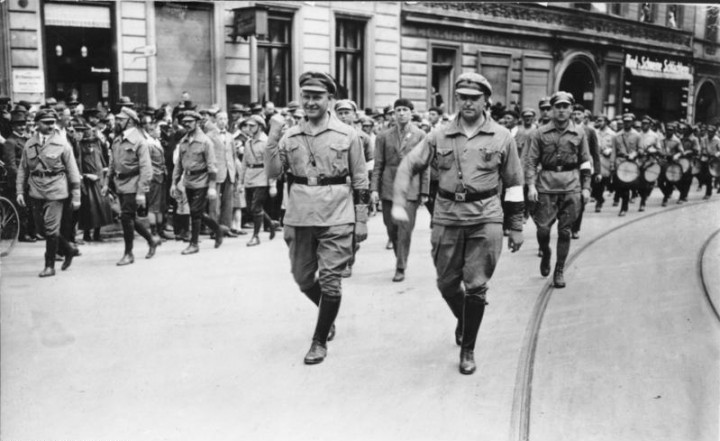 KPD military parade / Image: public domain
KPD military parade / Image: public domain
The middle class and the most downtrodden layers in particular were drawn in increasing numbers to the 'National Socialist' rallies. The fascists' demagogic attacks on capitalists and Jews; their mystical promise to restore German 'greatness'; above all, their appearance of purposeful determination seemed the only alternative to these layers.
Among organized workers, support for Hitler was almost non-existent.
Trotsky explained the critical need for a united front of workers' organizations to crush the fascist menace and, in so doing, to prepare the working class for the conquest of power. But the Stalinized leadership of the Comintern was blind and deaf to reality.
The German labour movement was the most powerful in the world. Both the Social-Democrats and the Communist Party had military wings. But, on Moscow's instructions, the KPD leaders refused all cooperation with the 'social-fascists' – even going so far, in 1931, as to join the Nazis in trying to bring down a Social-Democratic government in Prussia!
The German workers' movement, the hope of workers everywhere, was annihilated without any serious attempt at resistance by its leadership.
The Stalinists were incapable of drawing the conclusions. In April 1933, with Hitler in power, the Presidium of the ECCI declared that the KPD's policy had been "completely correct"!
This historical failure of leadership, and the absence of any criticism from the ranks of the Communist International, finally convinced Trotsky that the Cominterns –like the Second International before it – was dead as an instrument of workers' revolution.
The forces of genuine Marxism had been decimated by the savage blows of a decade. The perspective of a new world war, and new revolutionary upheavals, was opening up. Objectively, a new international was necessary to regroup, to build and prepare the Marxist tendency for the critical struggles ahead.
19. ...to the 'people's front'
The changed alignment of class forces in Europe rapidly pushed the Soviet regime into a new u-turn.
Germany under Hitler posed a far more immediate threat to them than the western imperialist powers. Above all, Stalin feared war and the effect it would have on the Soviet masses. To avoid war, he calculated, it was essential to appease Hitler.
Throughout 1933, while Hitler liquidated the KPD, the SPD and the trade unions, and began the genocide of the Jews, Stalin uttered not a word of criticism. Throughout the 1930s the Soviet bureaucracy hoped to reach an agreement with Hitler.
But Hitler was relying on the 'Communist menace' as a pretext for rearmament in defiance of his 'Allied' imperialist rivals. He could not be seen to fraternize with Stalin at this stage. (Only in August 1939, when Hitler was preparing to strike to the west, was the notorious Stalin-Hitler pact of non-aggression signed.)
Surrounded by fascist and right-wing regimes, Stalin's 'revolutionary' ultra-leftism evaporated. Trotsky and the International Left Opposition explained (as the Comintern had explained a dozen years earlier) that the only real security for the USSR lay in revolutionary internationalism – in supporting the workers' struggle for power in the capitalist states, carrying the war to the enemy and paralyzing reaction.
But the Russian bureaucracy were incapable of following this course; their own dictatorship would have been the first casualty if the Russian workers became infected with these ideas! Instead, quietly forgetting that capitalism was in its 'third period', they looked for support against Hitler to – the western imperialist powers!
The imperialists were not unwilling to use Stalin for their own purposes. In September 1934 they accepted the Soviet Union's application to join the League of Nations (describe by Lenin as a "robbers' den"); in May 1935 French imperialism signed a pact of 'mutual assistance' with Stalin!
This turn by the Soviet bureaucracy marked a qualitative new stage in their degeneration. For the first time they entered openly and deliberately, into political alliances with the capitalist class itself. Their opportunist failures, from this point onwards, became transformed into a deliberate betrayal of the workers' revolution internationally as a condition for capitalist 'friendship'.
The writing had been on the wall at the 1928 Comintern congress, where the idea of 'socialism in one country' was swallowed without a murmur. Trotsky warned that this would be "the beginning of the disintegration of the Comintern along the lines of social-patriotism". (The Third International After Lenin, page 55) After 1934 this prediction rapidly became a fact.
The Soviet bureaucracy's entanglement with the 'progressive' capitalist powers was followed, inevitably, by the turn of the Communist parties internationally seeking alliances with 'progressive' capitalist and reformist parties in their own countries.
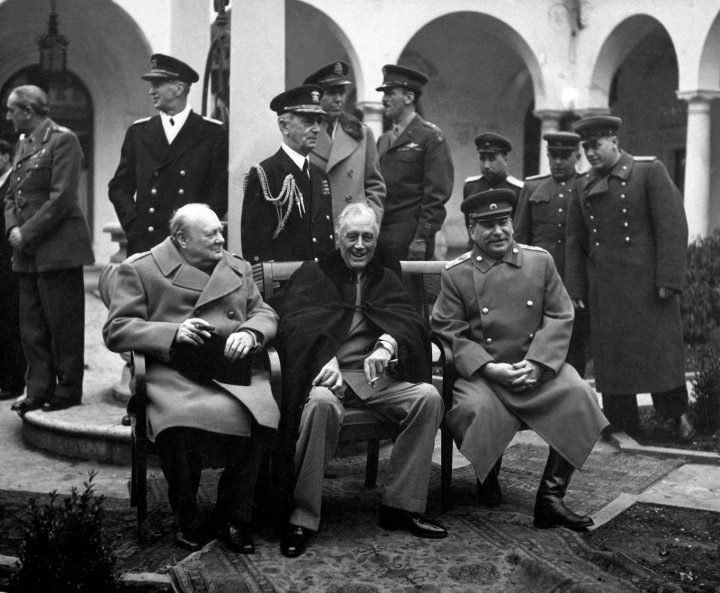 The Big Three / Image: public domain
The Big Three / Image: public domain
The slogan now became 'the people's front'. The workers' class demands were dropped from the programs which the Communist partied put forward - this would 'alienate' the 'progressive' bourgeoisie!
'Broad support' among the middle class, the Stalinists wisely proclaimed, could only be won through a program confined to bourgeois-democratic demands. Today the middle class is no longer a mass force in the industrialized countries; yet the same program and the same arguments are still used by the 'Communist' parties. This confirms that the real purpose, then as now, was not so much to win mass support as to build up a bargaining position in relation to the capitalist parties.
The full bankruptcy of this position was exposed in the revolutionary events that erupted in France and Spain during 1935 and 1936. First in France, then in Spain, 'Popular Front' governments swept to power with Communist support. In both countries, after the rigors of the depression and right-wing rule, this opened the floodgates of mass struggle.
In Spain, a military coup was launched against the 'People's Front' government in July 1936. The reformists, Stalinists and bourgeois Republicans dithered; the workers and peasants took up arms. Within days, most of the country was under their control. Spain was plunged into a full-scale revolutionary crisis, at a far higher level than Russia in 1917.
"Red rule in Barcelona - Extremists out of hand", headlined the London Times on August 1. Two days later its correspondent summed up the demands of the masses:
"a 36-hour week, unemployment pay, control of production, the seizure and distribution of land, ... the maintenance of the [workers'] militias in arms..."
and after another few days:
"'Committees of Workers' have taken over the big railway companies. It seems only a question of time for this to happen to the trams, the banks and other key establishments." (The Times, August 8, 1936)
Stalin, no less than the capitalist class, viewed the unfolding revolution with horror. All his hopes of stable ties with the Anglo-French imperialists were at risk. Worse still, the example of the Spanish workers threatened to infect the Russian workers with the same will to struggle for control of society. The Spanish Revolution had to be strangled at all costs.
Slavishly following Moscow's directives, the Communist Party of Spain waged an all-out struggle against the workers' revolutionary movement.
In the name of 'Bolshevism' they argued the Menshevik theory of 'two stages', confining their program to 'bourgeois democracy' in the futile hope of reassuring the capitalists that 'Communism' posed no threat to them. GPU death squads were sent to Spain to assist in the gruesome task of disarming the workers' militias and exterminating their vanguard.
Deferring to Stalin's wheeling and dealing with the imperialist powers, the 'Communists' shut their eyes to the first lesson of the Russian Revolution: capitalism cannot guarantee democracy and stability to the working class in the conclusive epoch of imperialism. The tasks of 'bourgeois democracy' in semi-developed countries such as Spain could only be carried out under the rule of the working class itself.
Tragically, Trotsky's sympathizers in Spain missed the golden opportunity of winning the Socialist youth to their program, establishing a mass base for Marxism and leading the movement to victory.
Without Marxist leadership the working class could not withstand the onslaught of the class enemy combined with that of their own reformist and 'Communist' leaders. Stalinism succeeded in dividing the movement, isolating the left and murdering its best fighters. This made the victory of fascism inevitable.
The last hope of working-class victory had been extinguished in Europe, at least until the conclusion of the imperialist war which now became unavoidable.
20. Rivers of blood
Inside the Soviet Union, the sharpening contradictions between the bureaucracy and the working class led to the liquidation of the remnants of the Bolshevik cadre.
The 'Communist' parties internationally were presenting the Soviet Union as the happy fatherland of socialism. Stalin's successor, Krushchev, at the 20th party congress in 1956, lifted a corner of the veil on what was really happening:
"Stalin acted not through persuasion, explanation and patient cooperation with people, but by imposing his concepts and demanding absolute submission to his opinion... He abandoned the method of ideological struggle for that of administrative violence, mass repressions and terror." (Quoted in The Moscow Trials, pages 17, 18)
Bureaucratic tyranny takes on a logic of its own. As repression intensifies, the rulers' fear of revenge increases. Opponents, driven from power, are mistrusted. Even if they recant, won't they become a threat again? Might they not provide the spark for insurrection from below?
Whole layers of the party came under intense suspicion from Stalin and the bureaucracy – none more so than the surviving 'Old Bolsheviks', who could remember the party of Lenin, who kept silent about the bureaucracy's crimes only out of fear.
Bukharin, as early as 1928, shrank back from the monster he had helped to create. In a secret discussion with Kamenev he exclaimed in terror: "What can we do? What can we do in the face of an adversary of this sort, a debased Genghis Khan...?" (Quoted by Serge, From Lenin to Stalin, page 91)
While the old Bolsheviks kept their heads down, a younger generation was coming to the fore, eager to restore the ideals of October. Contradictions were sharpening between the regime and the growing working class. The whole party seethed with discontent. Expulsions in the early 1930s ran into hundreds of thousands.
Yet the old Bolshevik leaders, despite their capitulations, commanded vastly greater respect than Stalin and the ruling bureaucratic clique – many of them disreputable ex-Mensheviks and former enemies of the October Revolution who had crossed to the winning side after the war.
These contradictions were brought to a head by the Spanish Revolution in 1936, sending shock waves through the workers' movement internationally, inspiring the Russian masses afresh with the example of workers' democracy in action.
The bureaucracy moved to nip the danger in the bud. With grisly irony, while protesting their commitment to bourgeois-democracy internationally, they unleashed a reign of purest nightmare in the Soviet Union itself.
There now took place the 'Moscow trials': incredible frame-ups where broken old Bolsheviks were accused of murder, sabotage, terrorism – any fantastic crime to discredit them and terrorize others.
But the main charge against them was 'Trotskyism'. One after another they were accused of 'conspiring with Trotsky', now vilified as an 'agent of capitalism' and a 'German spy' since 1921!
In this way the regime betrayed the real motive for the 'purges': their obsessive fear of Marxism, of workers' democracy and the workers' revenge, and their hatred of the foremost representative of Marxism in the labour movement internationally – Leon Trotsky.
As the Times correspondent in Russia admitted:
"The root of the matter is that Stalin never completely won the battle between his own policy and Trotsky's internationalist policy. Nor can final victory ever be his... Communism remains an international creed... lately, the discontent of zealot communists [revolutionaries] has increased... More still are alarmed at the great wage inequalities... It has been determined to silence the voice of opposition once and for all, and break the remnants of Trotskyism within the country." (August 21, 1936)
This there passed before Stalin's 'judges' a tragic parade of human wrecks who had once been Bolshevik leaders, blackmailed and cowed into admitting anything and everything demanded of them.
Three 'trials' were staged: in August 1936 (Zinoviev, Kamenev, Smirnov and others); January 1937 (Radek, Pyatakov and others); and February 1938 (Bukharin, Rykov, Rakovsky and others). Their accuser was the former Menshevik lawyer, Vyshinsky, who during the civil war had collaborated with the Whites. Now he could shriek the hatred of the bureaucracy against the former leaders of the revolution:
"Mad fascist police dogs!" "Despicable rotten dregs of humanity! Scum of the underworld! "Shoot the reptiles!"
No evidence was brought against the accused except their GPU-dictated 'confessions'. But, with one or two token exceptions, all were condemned to be shot.
Each of these murders, every curse by Vyshinsky, was admiringly reported and defended by the 'Communist' parties internationally.
Trotsky explained the logic of the whole grotesque performance:
"To justify the repressions, it was necessary to have framed accusations. To give weight to the false accusations, it was necessary to reinforce them with more brutal repressions. Thus the logic of the struggle drove Stalin along the road of gigantic judicial amalgams." (The Moscow Trials, page 129)
The Moscow trials were only the façade of what Trotsky termed "a one-sided civil war of the bureaucracy against the Bolshevik Party". Arrests followed waves of arrests. Countless old Bolsheviks, who refused to 'confess' in public, were assassinated in prison. Left Oppositionists in Siberian labour camps were taken out in groups to be shot. Altogether tens of thousands – the flower of the Russian workers' movement – were wiped out.
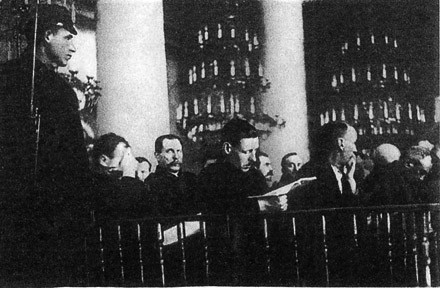 The Second Moscow Trial / Image: public domain
The Second Moscow Trial / Image: public domain
The Left Oppositionists remained revolutionaries to the end. An example of their unbending courage were the events at the Vorkuta labour camp in Siberia towards the end of 1936, when the Trotskyists led a massive fight-back by prisoners against the petty tyranny of the authorities with the only weapon still available to them – the hunger strike. (See Militant International Review, no 33, page 43)
After four months, all their demands were conceded. But soon the executions began. When a male political prisoner was shot, his wife and any children over the age of twelve would normally be killed as well.
Of the 1,966 delegates to the 17th CP congress in 1935, 1,108 had been arrested by 1938 for 'anti-revolutionary crimes'. Of 139 central committee members, 98 were shot.
Of 1,558,852 CP members in 1939, only 1.3 percent had belonged since the October Revolution. Of Lenin's Central Committee of 1917, only Stalin survived as a leader (ed: Kollontai and Muranov also lived by occupied greatly diminished positions), surrounded by ex-Mensheviks and bootlickers. The last vestiges of the Bolshevik Party had been eradicated.
One of the leaders of 1917, Raskolnikov, survived during the 1930s as Soviet ambassador to Bulgaria. Recalled to Moscow in 1938 for 'promotion' (i.e., to be shot), he fled into exile instead and wrote an open letter to Stalin:
"With the help of dirty forgeries, you staged false trials and made up accusations which are more ridiculous than the witch trials of the middle ages... Inert pulp writers glorify you as a semi-deity born of the sun and the moon and you, like an Eastern despot, enjoy the incense of crude flattery. You mercilessly exterminate talented writers who are personally displeasing to you... sooner or later, the Soviet people will put you on trial as a traitor to socialism and the revolution." (Published for the first time in the USSR in the magazine Ogonyok in June 1987)
The total death toll under Stalin in the 1930s is estimated at 12 to 15 million. Survivors, such as Raskolnikov, were understandably embittered and filled with hatred towards Stalin. But it must not be forgotten that this slaughter was not simply the consequence of power-hunger, ruthlessness or (as Krushchev falsely explained it) the "cult of the individual". It was the culmination of the political counter-revolution by the bureaucracy against the revolutionary working-class tendency in the Russian workers' state.
The regime established under Stalin had nothing in common with the regime of Lenin and Trotsky, though the outward trappings (the 'Communist Party', the 'Politbureau', the title 'soviets', etc.) were preserved to give the opposite impression. Rivers of blood separate Marxism from the regime of the Russian bureaucracy.
Testimony as to the historical significance of Stalinism is contained in the gloating poem that appeared in a White magazine after the first Moscow trial:
"We thank you, Stalin!
Sixteen scoundrels,
Sixteen butchers of the Fatherland
Have been gathered to their ancestors..."But why only sixteen?
Give us forty,
Give us hundreds,
Thousands;
Make a bridge across the Moscow river,
A bridge without tower or beams,
A bridge of Soviet carrion -
And add your carcass to the rest!"
21. Conclusion
Under the spreading terror of Stalinism in the Soviet Union and fascism in Western Europe, the forces of Marxism were decimated or extinguished during the 1930s. Only the genius and determination of Trotsky (murdered by a GPU agent in 1940), and a very small band of followers, remained to re-educate a coming generation in the ideas of the workers' struggle for socialism.
To the end of his life Trotsky continued to defend the gains of the October Revolution – in essence, the state-owned and planned economy – despite the monstrous bureaucratic deformation of the 'Soviet' regime, and rejected the idea that Russia had become 'state capitalist'.
At the same time, he explained that there was no possibility of 'reforming' the regime to re-establish workers' democracy. It would have to be defeated and overthrown by the mass movement of the working class, once again taking power into its own hands, to re-open the road to socialist transformation.
Outstanding among Trotsky's works is The Revolution Betrayed, providing a detailed and scientific explanation of the processes that have been outlined in this pamphlet.
Today the balance of forces in the Soviet Union is radically different. The working class is the most powerful and best-educated in the world. The bureaucracy has no role left; it had become an absolute obstacle to economic and social progress. Gorbachev's attempts to streamline the bureaucracy (like those of Brezhnev and Krushchev before him) cannot alter the historical bankruptcy of its rule.
Rather, it reflects a new stage in the crisis of Soviet Stalinism, in which the objective conditions are ripening for political revolution to overthrow the bureaucracy and restore the role of the working class.
Brilliant 'dress rehearsals' of the approaching political revolution have already been provided by the working class in Hungary in 1956, in Poland in 1980-81, etc.
Internationally, also, the conditions of the 1980s are the reverse of the late 1930s. Revolutionary movements are awakening in every sector of the world. The program of Marxism is once again gripping the minds of workers and youth from Liverpool to Sri Lanka, from South Africa to Spain.
The lessons of the triumph and degeneration of the Russian Revolution must be relearned in order to rise to the task that will face us in the next period: the conquest of power by the working class on every continent, the establishment of workers' democracy, and the socialist transformation of the world.

